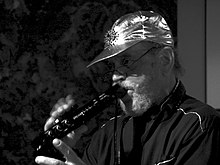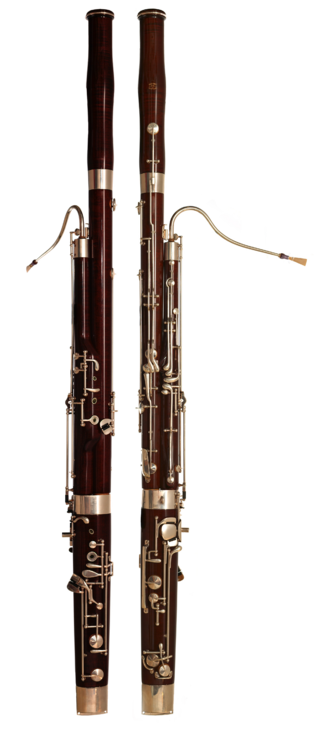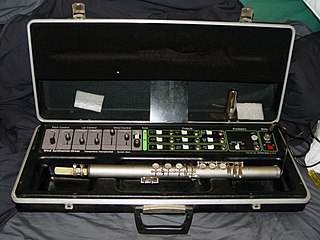
EWI (from electronic wind instrument, pronounced EE-wee) is a type of wind controller, an electronic musical instrument invented by Nyle Steiner. [1] [2] The EWI has been used by many artists across many different genres. [3]

EWI (from electronic wind instrument, pronounced EE-wee) is a type of wind controller, an electronic musical instrument invented by Nyle Steiner. [1] [2] The EWI has been used by many artists across many different genres. [3]

The EWI was invented by Nyle Steiner, his second electronic wind instrument design. Steiner originally brought to market a brass style fingering analogue wind synthesizer instrument known as the EVI in the 1970s. Steiner then went on to develop the EWI which had a unique fingering system closer to the woodwind style. These instrument designs first working models appeared in the 1970s, with the EWI appearing commercially during the early 1980s. [1]
EWI models can control external synthesizers or other MIDI instruments, either simultaneously or instead of the synthesizers that come with the instrument. Earlier EWIs require the external box unit, while the discontinued (as of 2019) EWI4000s and still currently available EWI5000 have built-in MIDI outputs. The newest EWI SOLO and the now discontinued (as of 2022) EWI USB have only a USB connector. [4] In 2021 a small volume (cottage industry) company Berglund also makes its own original variations on classic Steiner EVI and EWI designs, approved and demonstrated by Nyle Steiner himself. The Berglund designs offer MIDI over wireless, unlike the current Akai products (as of 2022). [5] Wireless MIDI can be achieved on the Akai models with unofficial third party add on products at lower cost, albeit in a somewhat DIY fashion.
Any EWI can play software synthesizers running on a computer.

The early models of EWI and EVI consisted of two parts: a wind controller and a digitally-controlled analog synthesizer in a rackmount box (which also houses the instrument's electronics). Akai took over the EVI and EWI instruments from Steiner and released several models with his help. Today Akai only makes designs based around the EWI, having dropped the less commercially successful EVI. The current Akai models EWI5000, and EWI SOLO contain built-in sample-based digital synthesizers and don't strictly require an external box. Akai also offered the EWI USB, a five-octave MIDI controller that connects directly to a Mac or Windows computer via USB and uses software for control.
EWIs, depending on the brand (Akai or Berglund; the latter referred to as NuRad), can use the Boehm fingering system used by most woodwind instruments, or other fingerings, like that of the recorder or tin whistle. The instrument feels somewhat like a soprano saxophone or clarinet, except that its keys are activated by touch rather than being depressed (i.e. the player's fingers don't rest on the keys).
Nyle Steiner's EWI fingering was novel because it does not operate as an acoustic instrument. Instead of closing or opening a hole, each EWI key acts as a pitch modifier that can change note values by plus or minus a half step or whole step. As a result, fingerings that are similar to that of a Boehm instrument, but many other alternate fingers are possible on EWI that are not possible on acoustic instruments. This gave Steiner's invention flexibility yet remains familiar to woodwind players. [6]
Later generation EWIs can be switched to flute, oboe, and saxophone fingering modes. [7] The EWI 5000 and EWI USB also have an electronic valve instrument (EVI) fingering mode that allows brass players to play the EWI. [8] Like a straight soprano saxophone or clarinet, the EWI is straight with a slight inward bend a few inches below the mouthpiece, and it is held in front of the body with a neck strap.

The EWI has a silicone mouthpiece with sensors for air pressure (sending MIDI Breath Control by default) and bite pressure (which sends vibrato, more specifically a quick pitch up-down "blip" by default, but can also be routed to modulation or other CC controls of the player's preference). Because the EWI keys do not move (instead, they sense when fingers are touching them by body capacitance). Owing to the touch capacitive switches and breath and bite sensors the instrument is highly responsive, however, this sensitive nature of the touch capacitive switches does not immediately appeal to all players, some of which may prefer electronic wind instruments with mechanical buttons on which they can rest their fingers, more similar to a saxophone, though a short period of adjustment will allow wind players to easily adapt. It also requires substantially less breath control than an acoustic instrument; breath sensitivity is one of the parameters that can be adjusted to the player's preference.

Unlike acoustic wind instruments, the fingering is identical in every octave. The current octave is determined by putting your left thumb between any two of the four to eight rollers (*depending on model), and also by rolling the thumb to the ends of the EWI USB roller track to achieve the fifth octave from just the four-octave rollers on that model. Touching a plate next to the rollers sends portamento by default (this portamento strip is not on the EWI USB). EWIs also have pitch bend up and down plates all operated by the right thumb. The latest EWI known as Solo only has pitch bend down plate so the player has to scoop up from the bottom pitch down plate before blowing a note for an upwards pitch bend which will be of a more limited range compared to all the other twin bend plate EWI models; this sacrifice apparently made as the thumb hold at the same position also supports the greater weight of the instrument. The Solo however has seen the addition of a dedicated F# key to the EWI key sensors. A key not seen before on previous EWI models, which should be welcome for players using the saxophone fingering mode instead of traditional EWI.

The bassoon is a musical instrument in the woodwind family, which plays in the tenor and bass ranges. It is composed of six pieces, and is usually made of wood. It is known for its distinctive tone color, wide range, versatility, and virtuosity. It is a non-transposing instrument and typically its music is written in the bass and tenor clefs, and sometimes in the treble. There are two forms of modern bassoon: the Buffet and Heckel systems. It is typically played while sitting using a seat strap, but can be played while standing if the player has a harness to hold the instrument. Sound is produced by rolling both lips over the reed and blowing direct air pressure to cause the reed to vibrate. Its fingering system can be quite complex when compared to those of other instruments. Appearing in its modern form in the 19th century, the bassoon figures prominently in orchestral, concert band, and chamber music literature, and is occasionally heard in pop, rock, and jazz settings as well. One who plays a bassoon is called a bassoonist.

An electronic musical instrument or electrophone is a musical instrument that produces sound using electronic circuitry. Such an instrument sounds by outputting an electrical, electronic or digital audio signal that ultimately is plugged into a power amplifier which drives a loudspeaker, creating the sound heard by the performer and listener.

The recorder is a family of woodwind musical instruments in the group known as internal duct flutes: flutes with a whistle mouthpiece, also known as fipple flutes. A recorder can be distinguished from other duct flutes by the presence of a thumb-hole for the upper hand and seven finger-holes: three for the upper hand and four for the lower. It is the most prominent duct flute in the western classical tradition.
Akai is a Hong Kong manufacturer of consumer electronics. It was founded as Akai Electric Company Ltd in Tokyo, Japan, in 1946.

An electronic keyboard, portable keyboard, or digital keyboard is an electronic musical instrument based on keyboard instruments. Electronic keyboards include synthesizers, digital pianos, stage pianos, electronic organs and digital audio workstations. In technical terms, an electronic keyboard is a rompler-based synthesizer with a low-wattage power amplifier and small loudspeakers.
Overblowing is the manipulation of supplied air through a wind instrument that causes the sounded pitch to jump to a higher one without a fingering change or the operation of a slide. Overblowing may involve a change in the air pressure, in the point at which the air is directed, or in the resonance characteristics of the chamber formed by the mouth and throat of the player.

Novation Digital Music Systems Ltd. is a British musical equipment manufacturer, founded in 1992 by Ian Jannaway and Mark Thompson as Novation Electronic Music Systems. Today the company specializes in MIDI controllers with and without keyboards, both analog and virtual analog performance synthesizers, grid-based performance controllers, and audio interfaces. At present, Novation products are primarily manufactured in China.
Keytar is a keyboard instrument similar to a synthesizer or MIDI controller that is supported by a strap around the neck and shoulders, similar to the way a guitar is held.

A MIDI controller is any hardware or software that generates and transmits Musical Instrument Digital Interface (MIDI) data to MIDI-enabled devices, typically to trigger sounds and control parameters of an electronic music performance. They most often use a musical keyboard to send data about the pitch of notes to play, although a MIDI controller may trigger lighting and other effects. A wind controller has a sensor that converts breath pressure to volume information and lip pressure to control pitch. Controllers for percussion and stringed instruments exist, as well as specialized and experimental devices. Some MIDI controllers are used in association with specific digital audio workstation software. The original MIDI specification has been extended to include a greater range of control features.

A sound module is an electronic musical instrument without a human-playable interface such as a piano-style musical keyboard. Sound modules have to be operated using an externally connected device, which is often a MIDI controller, of which the most common type is the musical keyboard. Another common way of controlling a sound module is through a sequencer, which is computer hardware or software designed to record and playback control information for sound-generating hardware. Connections between sound modules, controllers, and sequencers are generally made with MIDI, which is a standardized interface designed for this purpose.

Bass pedals are an electronic musical instrument with a foot-operated pedal keyboard with a range of one or more octaves. The earliest bass pedals from the 1970s consisted of a pedalboard and analog synthesizer tone generation circuitry packaged together as a unit. The bass pedals are plugged into a bass amplifier or PA system so that their sound can be heard. Since the 1990s, bass pedals are usually MIDI controllers, which have to be connected to a MIDI-compatible computer, electronic synthesizer keyboard, or synth module to produce musical tones. Some 2010s-era bass pedals have both an onboard synth module and a MIDI output.

A MIDI keyboard or controller keyboard is typically a piano-style electronic musical keyboard, often with other buttons, wheels and sliders, used as a MIDI controller for sending Musical Instrument Digital Interface (MIDI) commands over a USB or MIDI 5-pin cable to other musical devices or computers. MIDI keyboards lacking an onboard sound module cannot produce sounds themselves, however some models of MIDI keyboards contain both a MIDI controller and sound module.

The Lyricon is an electronic wind instrument, the first wind controller to be constructed.

A wind controller, sometimes referred to as a wind synthesizer, is an electronic wind instrument. It is usually a MIDI controller associated with one or more music synthesizers. Wind controllers are most commonly played and fingered like a woodwind instrument, usually the saxophone, with the next most common being brass fingering, particularly the trumpet. Models have been produced that play and finger like other acoustic instruments such as the recorder or the tin whistle. The most common form of wind controller uses electronic sensors to convert fingering, breath pressure, bite pressure, finger pressure, and other gesture or action information into control signals that affect musical sounds. The control signals or MIDI messages generated by the wind controller are used to control internal or external devices such as analog synthesizers or MIDI-compatible synthesizers, synth modules, softsynths, sequencers, or even non-instruments such as lighting systems.

A guitar synthesizer is any one of a number of musical instrument systems that allow a guitarist to access synthesizer capabilities.
A MIDIjet Pro is a long-range, wireless MIDI system created in 2005 by Artisan Classic Organ Inc. Its predecessor was a short-range wireless MIDI system called MIDIjet. It connects any two pieces of MIDI equipment wirelessly using standard 5-pin MIDI connectors.

The AX80 is a polyphonic analogue keyboard synthesizer manufactured by Akai Professional in 1984. It was Akai's first venture into the professional electronic musical instrument market. The AX80 used digitally controlled oscillators (DCO) and filter circuitry based on the Curtis Electronics CEM 3372 integrated circuit. It was marketed as part of a line of project studio equipment called the Akai Music Studio System, which included the S612 digital sampler the MR16 drum machine, the MS08 sequencer, and the MG1212 multitrack tape recorder, at a price of $1,695 US.

The AX60 is a polyphonic analogue keyboard synthesizer manufactured by Akai Professional in the mid-1980s. It was Akai's answer to the popular Roland Juno series synthesizers. The AX60 uses voltage-controlled analogue oscillators and filter circuitry based on the Curtis Electronics CEM 3394 integrated circuit.

The Seaboard is a musical keyboard-style MIDI controller manufactured by the British music technology company ROLI. It has a continuous sensor-embedded flexible rubber surface for playing the keys instead of traditional lever-style "moving keys". Some models, like the RISE Seaboard Grand, have an onboard sound engine. It has what the manufacturer calls "5D technology" which consists of five types of responsiveness to player actions: "strike", "glide" and "press", front to rear movement "slide" sensitivity, and release–velocity "lift". These responsiveness tools can be used to play the Seaboard with microtonal pitch bend sounds, by moving the finger from note to note, or trigger a vibrato effect into a string patch just by wiggling the finger, which would not be possible on a traditional MIDI controller using only the keys. The Seaboard also features polyphonic aftertouch, and a built-in USB- charged battery. There are three Seaboard models: the small minikey BLOCK, the RISE, and the GRAND, an 88-key keyboard with an onboard sound engine.
The 12 Step foot controller is a bass pedal-style programmable MIDI controller pedal keyboard made by Keith McMillen Instruments which was released in 2011. It has small, soft, rubbery keys that are played with the feet. As a MIDI controller, it does not make or output any musical sounds by itself; rather, it sends MIDI messages about which notes are played to an external synth module or computer music program running on a laptop or other computer. Each key on the 12 Step senses the velocity, aftertouch pressure, and the amount of tilt the player is applying with his feet. The messages from the player's foot presses can be sent via USB to a computer-based virtual instrument or to a synthesizer or other electronic or digital musical instrument.